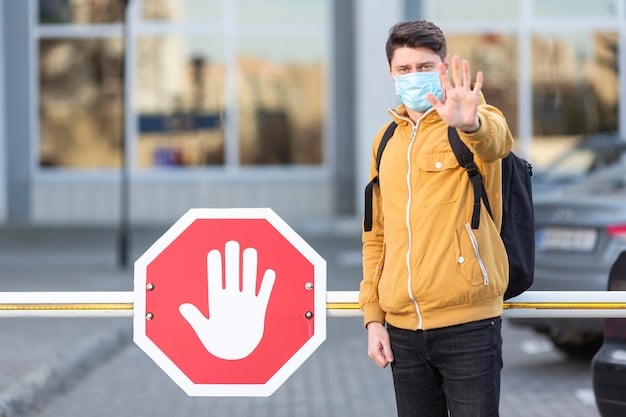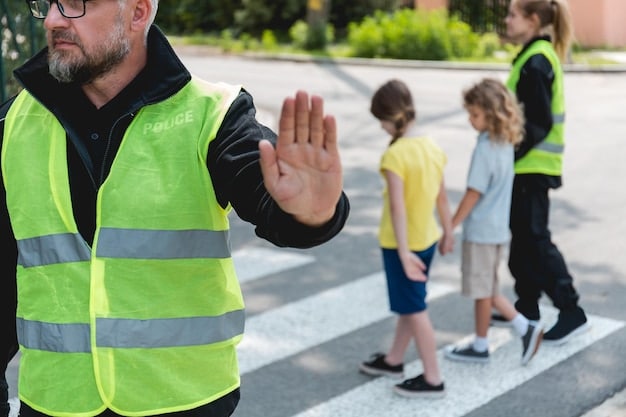School Zone Crossing Guard Training: Become a Community Protector

School zone crossing guard training equips individuals with the necessary skills and knowledge to safely guide children across streets near schools, ensuring their well-being and reducing traffic-related accidents in the community.
Ensuring the safety of children on their way to and from school is a paramount concern for communities across the United States. This is where the role of a school zone crossing guard becomes invaluable. School zone crossing guard training is the cornerstone of creating a safe environment for young pedestrians, providing them with a secure passage across busy streets.
Understanding the Importance of School Zone Crossing Guards
School zone crossing guards play a vital role in protecting children as they navigate their way to and from school. These dedicated individuals are strategically positioned at intersections and crosswalks to halt traffic, creating a secure environment for students. Their presence not only ensures immediate safety but also instills a sense of security among students and parents alike.
Reducing Traffic Accidents
One of the primary functions of school crossing guards is to minimize the risk of traffic accidents. By controlling the flow of vehicles and pedestrians, they prevent potential collisions and create a predictable environment for everyone. Their training equips them with the skills to assess traffic patterns, anticipate hazards, and take proactive measures to mitigate risks.
Creating a Safe and Orderly Environment
Beyond preventing accidents, school crossing guards contribute to a more orderly and safe environment around schools. Their presence helps manage pedestrian traffic, ensuring that students cross streets in a disciplined manner. This is particularly important in areas with high traffic volume or complex intersections.

Here are some key responsibilities of a school zone crossing guard:
- Ensuring children cross streets safely by stopping traffic.
- Remaining vigilant and watching for any potential hazards.
- Communicating effectively with students, parents, and drivers.
- Adhering to established safety protocols and procedures.
In conclusion, school zone crossing guards are indispensable members of the community, providing a crucial layer of safety for children traveling to and from school. Their training and dedication contribute significantly to reducing accidents and creating a secure environment for young pedestrians.
Essential Skills and Qualifications for Crossing Guards
To effectively fulfill their duties, school zone crossing guards must possess a range of skills and qualifications. These requirements ensure that they are well-prepared to handle the challenges of managing traffic and protecting children. While specific qualifications may vary by location, certain core competencies are universally valued.
Prospective crossing guards must demonstrate the following skills:
- Excellent communication skills: The ability to clearly communicate with children, parents, and drivers is essential.
- Alertness and vigilance: Crossing guards must remain attentive and aware of their surroundings at all times.
- Responsibility and reliability: Punctuality and dependability are crucial for ensuring consistent coverage at designated crossings.
- Physical fitness: The job requires standing for extended periods and enduring various weather conditions.
Background Checks and Clearances
Given their direct interaction with children, crossing guards are typically required to undergo thorough background checks and clearances. These measures help ensure the safety and well-being of students by verifying that crossing guards have no history of criminal activity or behavior that could pose a risk.
First Aid and CPR Certification
While not always mandatory, first aid and CPR certification are highly valuable for school zone crossing guards. These skills enable them to respond effectively in emergency situations, providing immediate assistance to injured children or adults until professional medical help arrives.

In summary, the qualifications and skills required for school zone crossing guards are designed to ensure they can effectively protect children and manage traffic safely. By meeting these requirements, crossing guards demonstrate their commitment to the well-being of the community’s youngest members.
Comprehensive School Zone Crossing Guard Training Programs
Comprehensive training programs are essential for preparing individuals to serve as effective school zone crossing guards. These programs equip trainees with the knowledge, skills, and confidence needed to handle the responsibilities of the job safely and effectively. A well-structured training curriculum covers a range of topics, from traffic laws and safety procedures to communication techniques and emergency response.
Here’s what a comprehensive training program should cover:
- Traffic laws and regulations specific to school zones
- Safe crossing techniques and procedures
- Effective communication strategies for interacting with children, parents, and drivers
- Emergency response protocols, including first aid and CPR
Practical Exercises and Simulations
In addition to classroom instruction, effective training programs incorporate practical exercises and simulations. These hands-on activities allow trainees to apply their knowledge in real-world scenarios, building confidence and competence. Simulations may involve practicing crossing techniques, responding to emergencies, and interacting with simulated pedestrians and vehicles.
Ongoing Professional Development
School crossing guard training is not a one-time event but rather an ongoing process of professional development. Regular refresher courses and updates on traffic laws and safety procedures are essential for ensuring that crossing guards remain current and capable. Ongoing training also provides an opportunity for crossing guards to share their experiences, learn from each other, and refine their skills.
By investing in comprehensive training programs, communities can ensure that their school zone crossing guards are well-prepared to protect children and create a safe environment for pedestrians. These programs are essential for building a team of dedicated and effective crossing guards who are committed to the well-being of the community’s youngest members.
Navigating Traffic Laws and Regulations
A thorough understanding of traffic laws and regulations is crucial for school zone crossing guards. They must be familiar with the specific rules and guidelines governing school zones, including speed limits, crosswalk markings, and pedestrian right-of-way laws. This knowledge enables them to make informed decisions and effectively manage traffic to ensure the safety of children.
Key aspects of traffic laws and regulations for crossing guards include:
- Understanding speed limits in school zones and enforcing them
- Recognizing crosswalk markings and pedestrian right-of-way laws
- Knowing how to safely stop traffic and guide pedestrians across the street
- Being aware of local ordinances and regulations related to school zones
Working with Law Enforcement
School zone crossing guards often work closely with local law enforcement agencies to ensure safety in school zones. This collaboration may involve reporting traffic violations, coordinating traffic control during special events, and receiving ongoing training and support from law enforcement officers. By working together, crossing guards and law enforcement can create a safer environment for children and reduce the risk of accidents.
Staying Updated on Changes
Traffic laws and regulations are subject to change, so it is important for school zone crossing guards to stay updated on the latest developments. This may involve attending refresher courses, reading relevant publications, and consulting with local law enforcement agencies. By staying informed, crossing guards can ensure that they are following the most current and effective safety practices.
In conclusion, a comprehensive understanding of traffic laws and regulations is essential for school zone crossing guards. This knowledge enables them to make informed decisions, effectively manage traffic, and work collaboratively with law enforcement to create a safe environment for children. Ongoing training and communication are key to staying updated on changes and ensuring that crossing guards are following the most current safety practices.
Effective Communication Techniques for Crossing Guards
Effective communication is a critical skill for school zone crossing guards. They must be able to communicate clearly and respectfully with children, parents, and drivers to ensure that everyone understands their instructions and follows safety guidelines. Good communication skills can help prevent accidents, reduce confusion, and create a more positive environment around schools.
Communicating with Children
When interacting with children, crossing guards should use simple, age-appropriate language and be patient and understanding. They should explain the rules clearly and provide encouragement and positive reinforcement. It is also important to be aware of children’s developmental stages and adjust communication strategies accordingly.
Communicating with Parents
Parents are important partners in ensuring the safety of school zones. Crossing guards should communicate with parents in a polite and professional manner, providing information about safety guidelines and addressing any concerns they may have. Building positive relationships with parents can help create a more cooperative and supportive environment around schools.
Essential communication techniques for crossing guards include:
- Using clear and concise language that is easy to understand
- Being polite and respectful in all interactions
- Actively listening to others and responding to their questions and concerns
- Using visual aids, such as hand signals and signs, to reinforce verbal instructions
In summary, effective communication is a critical skill for school zone crossing guards. By communicating clearly and respectfully with children, parents, and drivers, crossing guards can help prevent accidents, reduce confusion, and create a more positive environment around schools. Strong communication skills are essential for building trust and cooperation within the community.
The Role of School Crossing Guards in Community Safety
School zone crossing guards play a vital role in community safety by providing a safe passage for children to cross streets near schools. Their presence not only protects students from traffic-related accidents but also contributes to a sense of security and well-being in the community. By ensuring that children can walk to and from school safely, crossing guards help promote healthy lifestyles and reduce traffic congestion.
Building Relationships with the Community
School zone crossing guards often become familiar faces in the community, building relationships with students, parents, and residents. These relationships can help create a more positive and supportive environment around schools, as well as foster a sense of shared responsibility for safety. Crossing guards can also serve as valuable resources for information and assistance.
Promoting Safe Walking and Biking
By creating safe routes to school, crossing guards encourage more students to walk or bike, which has numerous benefits for both individuals and the community. Walking and biking promote physical activity, reduce traffic congestion, and lower air pollution. Crossing guards also play a role in educating students and parents about safe walking and biking practices.
Benefits of school crossing guards in community safety include:
- Reducing traffic accidents involving children
- Creating a safer and more secure environment around schools
- Promoting healthy lifestyles and reducing traffic congestion
- Building relationships and fostering a sense of community
In conclusion, school zone crossing guards are invaluable members of the community, contributing to safety, health, and well-being. Their dedication to protecting children and promoting safe walking and biking practices makes a positive impact on the lives of students, parents, and residents alike. Communities that invest in school crossing guard programs demonstrate their commitment to the safety and well-being of their youngest members.
| Key Point | Brief Description |
|---|---|
| 🚦 Safety First | Protecting children near school zones. |
| 👩🏫 Training | Essential skills for effective guarding. |
| 🤝 Communication | Clear interaction with kids and drivers. |
| 👮 Law Adherence | Following traffic rules to ensure safety. |
Frequently Asked Questions
▼
Training equips crossing guards with essential skills to manage traffic and ensure children’s safety effectively, reducing the risk of accidents.
▼
Training covers traffic laws, communication techniques, emergency response, and safe crossing procedures to handle various situations confidently.
▼
Certification usually involves completing a recognized training program, passing background checks, and meeting local qualifications set by authorities.
▼
Responsibilities include safely guiding children across streets, watching for hazards, communicating with drivers, and adhering to safety protocols.
▼
Crossing guards promote community safety by preventing accidents, encouraging safe walking habits, and building positive relationships within the neighborhood.
Conclusion
In summary, school zone crossing guard training is a vital investment in the safety and well-being of students and the community as a whole. By equipping individuals with the necessary skills and knowledge, these training programs help create a safer environment for children walking to and from school. Their presence not only prevents accidents but also fosters a sense of security and promotes healthy lifestyles. Communities that prioritize crossing guard training demonstrate their commitment to protecting their youngest members and ensuring a safe and thriving environment for all.





